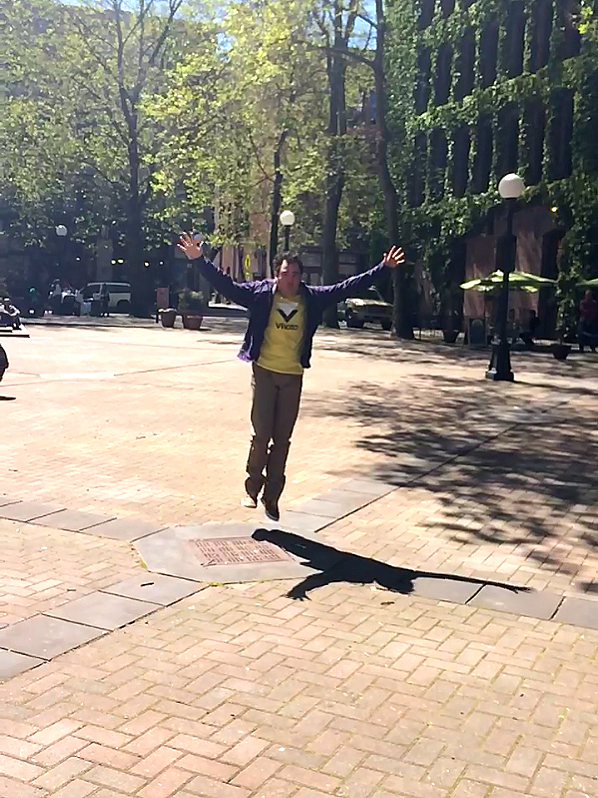
There are amazing photos hidden in all of the those videos you’ve shot on your mobile phone over the past few years.
You just don’t know it, or have a means to access them.
 But that could change starting today with the launch of Vhoto, a new iPhone app that uses computer vision technology to intelligently scan videos you’ve taken to find the best photographic moments.
But that could change starting today with the launch of Vhoto, a new iPhone app that uses computer vision technology to intelligently scan videos you’ve taken to find the best photographic moments.
“Everyone has had trouble hitting the button at the right moment to get the perfect shot. And everyone is forced to choose between photo and video every time we want to capture an amazing moment,” says Vhoto CEO Noah Heller, the 36-year-old former Microsoft Xbox and Activision vet who started the company two years ago in Boston with former Farecast CEO Hugh Crean.
Heller and Crean imagined a better way to get photos — just shoot video the entire time and let technology do the rest to find the best shots.
To get the concept rolling, Heller and Crean recruited one of Seattle’s most accomplished technology executives: Jay Bartot.
Bartot has been around the block a few times in Seattle’s technology scene, most recently serving as CTO of Medify, a startup company that sold to Alliance Health Networks in May 2012. Prior to that, Bartot served as vice president of engineering at Farecast, the airfare prediction startup that Crean led and Microsoft acquired in 2008 for $115 million. He also played key engineering roles at companies such as AdRelevance, Netbot and Sightward.
Together, Crean, Heller and Bartot are attempting to reinvent photography through video. If they have their way, mobile photographers no longer will take individual photos, instead shooting a stream of video in order to get the best shot.
“We are fundamentally trying to change the way photos are taken,” says Heller. “We have this paradigm around taking stills, hitting the button at the right time, that’s a holdover from 35 millimeter cameras. It so arbitrary that you have to hit the shutter button to get a great moment. It is so arbitrary that we have to choose between photo and video, when to a computer there is no difference.”
With Vhoto, the technology essentially makes a better photo almost in a “magical way,” he said.
Showing off the technology at the GeekWire offices, Heller took a short video of me while I interviewed him. From that, he was able to pull out a few compelling photos. (Or at least as compelling as photos get of a tech journalist doing an interview).
Why would someone prefer a photo when a video is available?

Heller said that watching a video takes time, and that the most special moments are sometimes lost. To illustrate that point, Heller showed a video of Crean’s 2-year-old nephew hitting a baseball for the first time.
With Vhoto, they were able to capture the most important moment of the video, the point of impact at which the youngster made contact with the ball. That photo was circulated to Crean’s family members, who thought he was a magician for somehow capturing that shot.
“One of our basic ideas is that there is an atomic unit to video, that there is a single moment or moments in a video that describes just what the video is about,” he said.
Given the track records of the execs, the Seattle company has had little trouble raising venture capital, pulling in $2.4 million from Atlas Venture and Polaris Venture Partners. (Interestingly, those are two Boston-area venture firms that pulled branch offices out of Seattle in the past decade). More money is on the way, as the Vhoto crew looks to create a critical mass of users.
The company now employs 13 people, operating from offices in Seattle’s Pioneer Square neighborhood.
One of the big challenges facing Vhoto is storage. After all, videos are big files. That’s an issue Heller readily admits, noting that the company may cap the amount of free storage available to users of the app.
 Over time, Vhoto could move beyond a consumer application, especially as the technology gets better at recognizing images, shapes, colors and textures. One could imagine security applications, pinpointing behaviors or activities that don’t properly fit.
Over time, Vhoto could move beyond a consumer application, especially as the technology gets better at recognizing images, shapes, colors and textures. One could imagine security applications, pinpointing behaviors or activities that don’t properly fit.
And while Heller has contemplated such applications, for now he’s satisfied with the idea of trying to make people better photographers.
“If we can credibly start delivering shots that are better, that feels ground-shaking for us,” he said.





